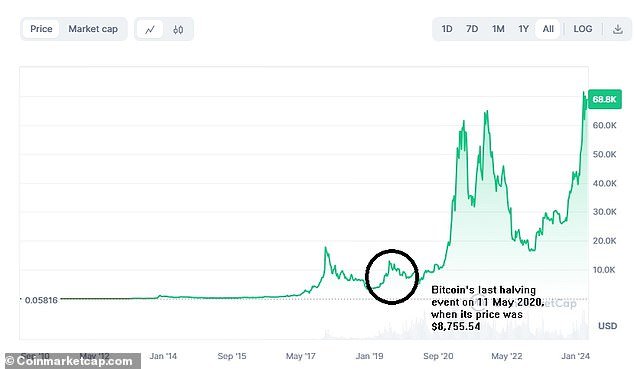Why is Bitcoin halving this weekend? How the event could affect the value of the cryptocurrency
- April marks the first bitcoin halving since May 11, 2020
- The next halving is expected to take place sometime in 2028
This weekend will see the first Bitcoin halving in almost four years, beginning a new chapter for the world’s largest cryptocurrency and the scale at which it is mined.
In recent months, the price of bitcoin has soared, with the introduction of spot price ETFs in the US pushing gains to new all-time highs above $70,000.
Bitcoin’s price has fallen slightly from a peak of $73,805.27 in March, reflecting broad volatility in risk asset prices amid escalating tensions in the Middle East. But investors are ready for the first asset halving since May 2020.
This is Money looks at what the bitcoin halving is, why it’s happening now and how it could affect its value.
In an effort to control the supply of new bitcoins, halving will occur when 210,000 blocks are mined, with the reward for successful mining reduced by 50 percent
What is bitcoin mining?
Before we understand how halving works, it’s important to understand how new bitcoin comes into circulation.
Bitcoin mining is the process of executing transactions as new bitcoins enter circulation on a blockchain.
The purpose of mining is to validate transactions to prevent fraud and add new blocks to the blockchain ledger.
Bitcoin mining involves using a powerful computer to solve complex hash puzzles. The first user – or miner – to solve the puzzle will be rewarded with bitcoin.
What is bitcoin halving?
In an effort to control the supply of new bitcoin, halving will occur when 210,000 blocks are mined, with the reward for successful mining reduced by 50 percent.
This happens about every four years and helps smooth Bitcoin’s new supply, which is limited to 21 million coins.
The next halving is expected to take place this weekend.
It is expected that by 2140 the total limit on the number of bitcoins available will be reached.
Why does it happen?
It’s hard to know for sure why bitcoin is set up this way.
As Etoro market analyst Simon Peters notes, bitcoin creator Satoshi Nakamoto keeps a very low profile with his last public statements in 2010.
Many believe that Nakamoto may not even exist and that the name is a pseudonym used by the original creator (or creators) of bitcoin.
Peters says that “the most logical theory” is that by gradually reducing the amount of new coins entering circulation, “halving helps increase the value of the network over time.”
He adds: “This month’s halving will see the reward drop from 6.25 to 3.125 bitcoin per block, meaning annual supply inflation will effectively drop from 1.7 percent to 0.84 percent.”
How can halving affect the price of bitcoin?
Bundeep Rangar, CEO of Fineqia International, told This Is Money that bitcoin halving events have “historically been associated with significant price increases.”
He explained that the reduction in the number of new coins leads to a decrease in selling pressure on miners.
This can therefore contribute to a supply shortage and push up prices if demand remains constant or increases.
Coinpass CEO Jeff Hancock said halving events are typically associated with “volatility and interest” in the bitcoin market.
But Hancock expects the next four-year cycle to be different from the last.
He says: ‘We are currently in an environment of high inflation and high interest rates. The bitcoin market has grown from a hobby for crypto enthusiasts to a real asset with institutional interest.’
Etoro’s Peters adds that many in the crypto community believe this month’s halving could push the price of bitcoin towards the six-figure mark.
He says: ‘The last bitcoin halving took place in May 2020, when the price was around £7,000, a small fraction of what it is today.
“With investor interest in bitcoin already reignited by the approval of spot ETFs earlier this year, many in the crypto community believe this month’s halving could fuel even more positive sentiment around bitcoin and push the price towards the $100,000 could push.”
After this event, when will the next halving occur?
Although it is difficult to say exactly when this date will take place, Peters estimates that it will probably be towards the end of the first quarter of 2028.
Fineqia’s Rangar added: “Given that each block is mined approximately every 10 minutes, and at an average of 144 blocks per day, the next halving should occur approximately four years after the date of the current halving.”

Bitcoin was trading below $9,000 before the latest halving

